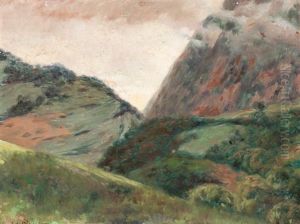Alexandre de Riquer Paintings
Alexandre de Riquer Inglada was a prominent figure in the Catalan Modernisme movement, which is the Catalan equivalent of Art Nouveau. Born on May 3, 1856, in Calaf, Spain, he was a multifaceted artist, known for his work as a painter, graphic designer, illustrator, and engraver.
Riquer descended from an aristocratic family, which allowed him the freedom to pursue his artistic interests. He was educated in France and England as well as in Spain, and these experiences abroad had a significant influence on his artistic development. He became one of the leading figures in introducing Art Nouveau trends to Spain. He was particularly influenced by the Pre-Raphaelite movement in England and the work of artists such as Edward Burne-Jones and Dante Gabriel Rossetti.
Throughout his career, Riquer contributed significantly to the graphic arts, and his work was characterized by a meticulous attention to detail, a love for nature, and an interest in medieval romanticism. He produced numerous illustrations for books, magazines, posters, and ex libris. Notably, he became a key contributor to the magazine 'L'Avenç' and played a pivotal role in the development of the editorial illustration in Catalonia. He was also involved in the design of banknotes and stamps.
Riquer's artistic output expanded beyond graphic work. He was a painter, though his paintings are less known compared to his graphic designs. As a devotee to the ideals of the Arts and Crafts Movement, he also engaged in designing furniture and other decorative objects, contributing to interior design projects.
He was a founding member of important artistic societies, such as the Sociedad de Acuarelistas de Barcelona (Barcelona Watercolourists' Society) and the Círculo Artístico de Sant Lluc (Artistic Circle of Saint Luke), which aimed to promote the arts in Catalonia. His role as a mentor and inspiration to younger artists was also significant, as he helped shape the artistic scene in Barcelona at the turn of the century.
Alexandre de Riquer passed away on November 13, 1920, in Palma, Mallorca, leaving behind a legacy as one of the principal representatives of the Modernisme movement in Catalonia. His work continues to be celebrated for its intricate beauty and its importance to the development of Catalan art and design.






